Chengqing Zong
National Laboratory of Pattern Recognition, Institute of Automation, CAS, Beijing, China, School of Artificial Intelligence, University of Chinese Academy of Sciences, Beijing, China
Parallel Scaling Law: Unveiling Reasoning Generalization through A Cross-Linguistic Perspective
Oct 02, 2025Abstract:Recent advancements in Reinforcement Post-Training (RPT) have significantly enhanced the capabilities of Large Reasoning Models (LRMs), sparking increased interest in the generalization of RL-based reasoning. While existing work has primarily focused on investigating its generalization across tasks or modalities, this study proposes a novel cross-linguistic perspective to investigate reasoning generalization. This raises a crucial question: $\textit{Does the reasoning capability achieved from English RPT effectively transfer to other languages?}$ We address this by systematically evaluating English-centric LRMs on multilingual reasoning benchmarks and introducing a metric to quantify cross-lingual transferability. Our findings reveal that cross-lingual transferability varies significantly across initial model, target language, and training paradigm. Through interventional studies, we find that models with stronger initial English capabilities tend to over-rely on English-specific patterns, leading to diminished cross-lingual generalization. To address this, we conduct a thorough parallel training study. Experimental results yield three key findings: $\textbf{First-Parallel Leap}$, a substantial leap in performance when transitioning from monolingual to just a single parallel language, and a predictable $\textbf{Parallel Scaling Law}$, revealing that cross-lingual reasoning transfer follows a power-law with the number of training parallel languages. Moreover, we identify the discrepancy between actual monolingual performance and the power-law prediction as $\textbf{Monolingual Generalization Gap}$, indicating that English-centric LRMs fail to fully generalize across languages. Our study challenges the assumption that LRM reasoning mirrors human cognition, providing critical insights for the development of more language-agnostic LRMs.
Single-to-mix Modality Alignment with Multimodal Large Language Model for Document Image Machine Translation
Jul 10, 2025Abstract:Document Image Machine Translation (DIMT) aims to translate text within document images, facing generalization challenges due to limited training data and the complex interplay between visual and textual information. To address these challenges, we introduce M4Doc, a novel single-to-mix modality alignment framework leveraging Multimodal Large Language Models (MLLMs). M4Doc aligns an image-only encoder with the multimodal representations of an MLLM, pre-trained on large-scale document image datasets. This alignment enables a lightweight DIMT model to learn crucial visual-textual correlations during training. During inference, M4Doc bypasses the MLLM, maintaining computational efficiency while benefiting from its multimodal knowledge. Comprehensive experiments demonstrate substantial improvements in translation quality, especially in cross-domain generalization and challenging document image scenarios.
Group then Scale: Dynamic Mixture-of-Experts Multilingual Language Model
Jun 14, 2025Abstract:The curse of multilinguality phenomenon is a fundamental problem of multilingual Large Language Models (LLMs), where the competition between massive languages results in inferior performance. It mainly comes from limited capacity and negative transfer between dissimilar languages. To address this issue, we propose a method to dynamically group and scale up the parameters of multilingual LLM while boosting positive transfer among similar languages. Specifically, the model is first tuned on monolingual corpus to determine the parameter deviation in each layer and quantify the similarity between languages. Layers with more deviations are extended to mixture-of-experts layers to reduce competition between languages, where one expert module serves one group of similar languages. Experimental results on 18 to 128 languages show that our method reduces the negative transfer between languages and significantly boosts multilingual performance with fewer parameters. Such language group specialization on experts benefits the new language adaptation and reduces the inference on the previous multilingual knowledge learned.
From Generic Empathy to Personalized Emotional Support: A Self-Evolution Framework for User Preference Alignment
May 22, 2025Abstract:Effective emotional support hinges on understanding users' emotions and needs to provide meaningful comfort during multi-turn interactions. Large Language Models (LLMs) show great potential for expressing empathy; however, they often deliver generic and one-size-fits-all responses that fail to address users' specific needs. To tackle this issue, we propose a self-evolution framework designed to help LLMs improve their responses to better align with users' implicit preferences concerning user profiles (personalities), emotional states, and specific situations. Our framework consists of two distinct phases: \textit{(1)} \textit{Emotional Support Experience Acquisition}, where LLMs are fine-tuned on limited emotional support conversation data to provide basic support, and \textit{(2)} \textit{Self-Improvement for Personalized Emotional Support}, where LLMs leverage self-reflection and self-refinement to generate personalized responses. Through iterative direct preference optimization between the pre- and post-refined responses, our model generates responses that reflect a better understanding of the user's implicit preferences. Extensive experiments and evaluations demonstrate that our method significantly enhances the model's performance in emotional support, reducing unhelpful responses and minimizing discrepancies between user preferences and model outputs.
TROVE: A Challenge for Fine-Grained Text Provenance via Source Sentence Tracing and Relationship Classification
Mar 19, 2025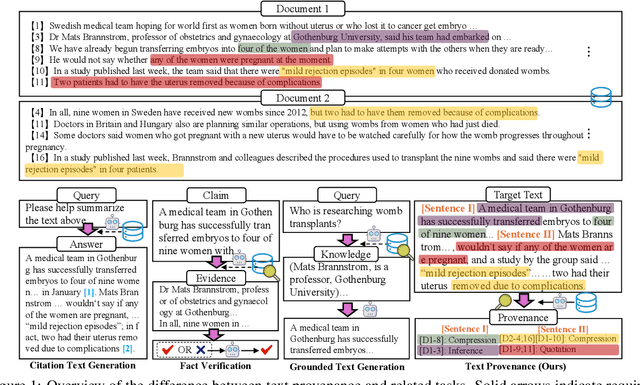
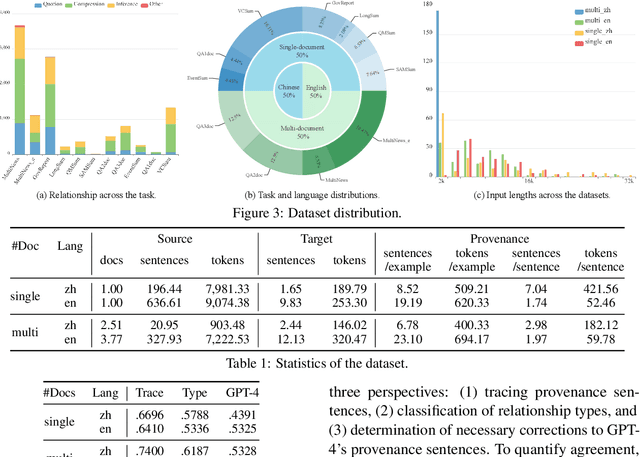

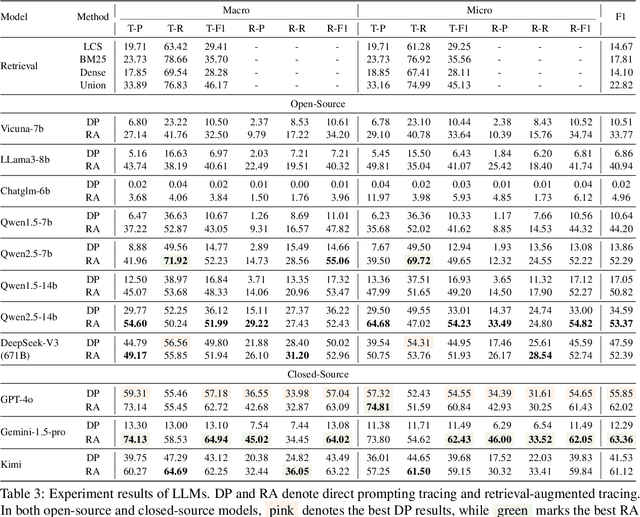
Abstract:LLMs have achieved remarkable fluency and coherence in text generation, yet their widespread adoption has raised concerns about content reliability and accountability. In high-stakes domains such as healthcare, law, and news, it is crucial to understand where and how the content is created. To address this, we introduce the Text pROVEnance (TROVE) challenge, designed to trace each sentence of a target text back to specific source sentences within potentially lengthy or multi-document inputs. Beyond identifying sources, TROVE annotates the fine-grained relationships (quotation, compression, inference, and others), providing a deep understanding of how each target sentence is formed. To benchmark TROVE, we construct our dataset by leveraging three public datasets covering 11 diverse scenarios (e.g., QA and summarization) in English and Chinese, spanning source texts of varying lengths (0-5k, 5-10k, 10k+), emphasizing the multi-document and long-document settings essential for provenance. To ensure high-quality data, we employ a three-stage annotation process: sentence retrieval, GPT provenance, and human provenance. We evaluate 11 LLMs under direct prompting and retrieval-augmented paradigms, revealing that retrieval is essential for robust performance, larger models perform better in complex relationship classification, and closed-source models often lead, yet open-source models show significant promise, particularly with retrieval augmentation.
Implicit Cross-Lingual Rewarding for Efficient Multilingual Preference Alignment
Mar 06, 2025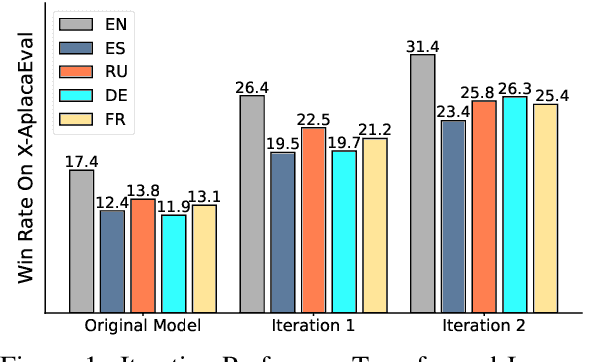



Abstract:Direct Preference Optimization (DPO) has become a prominent method for aligning Large Language Models (LLMs) with human preferences. While DPO has enabled significant progress in aligning English LLMs, multilingual preference alignment is hampered by data scarcity. To address this, we propose a novel approach that $\textit{captures}$ learned preferences from well-aligned English models by implicit rewards and $\textit{transfers}$ them to other languages through iterative training. Specifically, we derive an implicit reward model from the logits of an English DPO-aligned model and its corresponding reference model. This reward model is then leveraged to annotate preference relations in cross-lingual instruction-following pairs, using English instructions to evaluate multilingual responses. The annotated data is subsequently used for multilingual DPO fine-tuning, facilitating preference knowledge transfer from English to other languages. Fine-tuning Llama3 for two iterations resulted in a 12.72% average improvement in Win Rate and a 5.97% increase in Length Control Win Rate across all training languages on the X-AlpacaEval leaderboard. Our findings demonstrate that leveraging existing English-aligned models can enable efficient and effective multilingual preference alignment, significantly reducing the need for extensive multilingual preference data. The code is available at https://github.com/ZNLP/Implicit-Cross-Lingual-Rewarding
SweetieChat: A Strategy-Enhanced Role-playing Framework for Diverse Scenarios Handling Emotional Support Agent
Dec 11, 2024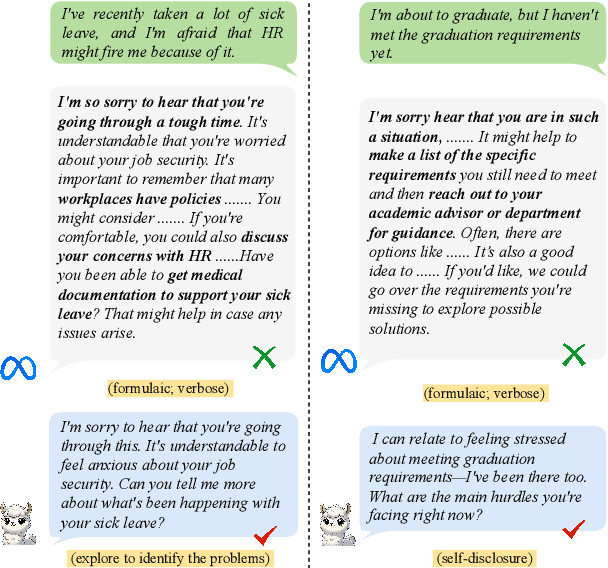
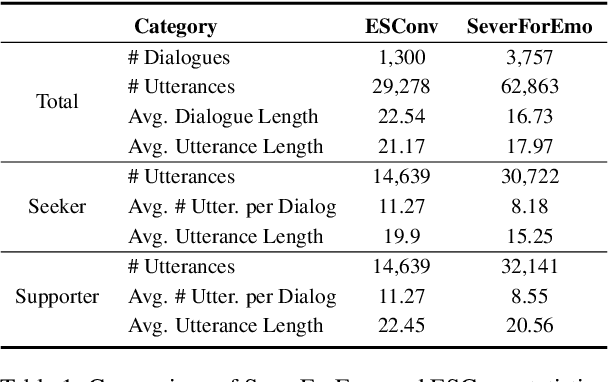
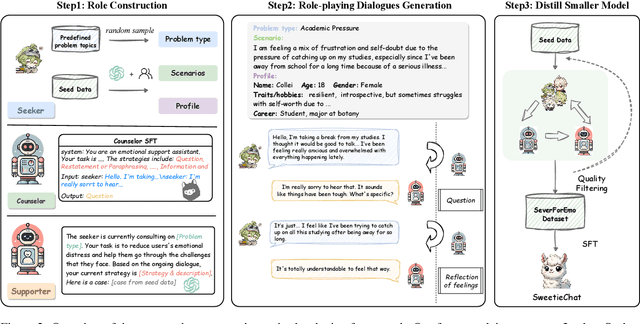
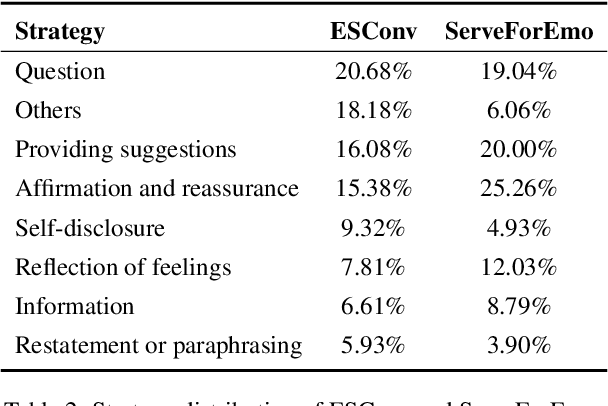
Abstract:Large Language Models (LLMs) have demonstrated promising potential in providing empathetic support during interactions. However, their responses often become verbose or overly formulaic, failing to adequately address the diverse emotional support needs of real-world scenarios. To tackle this challenge, we propose an innovative strategy-enhanced role-playing framework, designed to simulate authentic emotional support conversations. Specifically, our approach unfolds in two steps: (1) Strategy-Enhanced Role-Playing Interactions, which involve three pivotal roles -- Seeker, Strategy Counselor, and Supporter -- engaging in diverse scenarios to emulate real-world interactions and promote a broader range of dialogues; and (2) Emotional Support Agent Training, achieved through fine-tuning LLMs using our specially constructed dataset. Within this framework, we develop the \textbf{ServeForEmo} dataset, comprising an extensive collection of 3.7K+ multi-turn dialogues and 62.8K+ utterances. We further present \textbf{SweetieChat}, an emotional support agent capable of handling diverse open-domain scenarios. Extensive experiments and human evaluations confirm the framework's effectiveness in enhancing emotional support, highlighting its unique ability to provide more nuanced and tailored assistance.
ChineseWebText 2.0: Large-Scale High-quality Chinese Web Text with Multi-dimensional and fine-grained information
Nov 29, 2024



Abstract:During the development of large language models (LLMs), pre-training data play a critical role in shaping LLMs' capabilities. In recent years several large-scale and high-quality pre-training datasets have been released to accelerate the research of LLMs, including ChineseWebText1.0, C4, Pile, WanJuan, MAPCC and others. However, as LLMs continue to evolve, focus has increasingly shifted to domain-specific capabilities and safety concerns, making those previous coarse-grained texts insufficient for meeting training requirements. Furthermore, fine-grained information, such as quality, domain and toxicity, is becoming increasingly important in building powerful and reliable LLMs for various scenarios. To address these challenges, in this paper we propose a new tool-chain called MDFG-tool for constructing large-scale and high-quality Chinese datasets with multi-dimensional and fine-grained information. First, we employ manually crafted rules to discard explicit noisy texts from raw contents. Second, the quality evaluation model, domain classifier, and toxicity evaluation model are well-designed to assess the remaining cleaned data respectively. Finally, we integrate these three types of fine-grained information for each text. With this approach, we release the largest, high-quality and fine-grained Chinese text ChineseWebText2.0, which consists of 3.8TB and each text is associated with a quality score, domain labels, a toxicity label and a toxicity score, facilitating the LLM researchers to select data based on various types of fine-grained information. The data, codes and the tool-chain are available on this website https://github.com/CASIA-LM/ChineseWebText-2.0
Boosting LLM Translation Skills without General Ability Loss via Rationale Distillation
Oct 17, 2024



Abstract:Large Language Models (LLMs) have achieved impressive results across numerous NLP tasks but still encounter difficulties in machine translation. Traditional methods to improve translation have typically involved fine-tuning LLMs using parallel corpora. However, vanilla fine-tuning often leads to catastrophic forgetting of the instruction-following capabilities and alignment with human preferences, compromising their broad general abilities and introducing potential security risks. These abilities, which are developed using proprietary and unavailable training data, make existing continual instruction tuning methods ineffective. To overcome this issue, we propose a novel approach called RaDis (Rationale Distillation). RaDis harnesses the strong generative capabilities of LLMs to create rationales for training data, which are then "replayed" to prevent forgetting. These rationales encapsulate general knowledge and safety principles, acting as self-distillation targets to regulate the training process. By jointly training on both reference translations and self-generated rationales, the model can learn new translation skills while preserving its overall general abilities. Extensive experiments demonstrate that our method enhances machine translation performance while maintaining the broader capabilities of LLMs across other tasks. This work presents a pathway for creating more versatile LLMs that excel in specialized tasks without compromising generality and safety.
Language Imbalance Driven Rewarding for Multilingual Self-improving
Oct 11, 2024Abstract:Large Language Models (LLMs) have achieved state-of-the-art performance across numerous tasks. However, these advancements have predominantly benefited "first-class" languages such as English and Chinese, leaving many other languages underrepresented. This imbalance, while limiting broader applications, generates a natural preference ranking between languages, offering an opportunity to bootstrap the multilingual capabilities of LLM in a self-improving manner. Thus, we propose $\textit{Language Imbalance Driven Rewarding}$, where the inherent imbalance between dominant and non-dominant languages within LLMs is leveraged as a reward signal. Iterative DPO training demonstrates that this approach not only enhances LLM performance in non-dominant languages but also improves the dominant language's capacity, thereby yielding an iterative reward signal. Fine-tuning Meta-Llama-3-8B-Instruct over two iterations of this approach results in continuous improvements in multilingual performance across instruction-following and arithmetic reasoning tasks, evidenced by an average improvement of 7.46% win rate on the X-AlpacaEval leaderboard and 13.9% accuracy on the MGSM benchmark. This work serves as an initial exploration, paving the way for multilingual self-improvement of LLMs.
 Add to Chrome
Add to Chrome Add to Firefox
Add to Firefox Add to Edge
Add to Edge